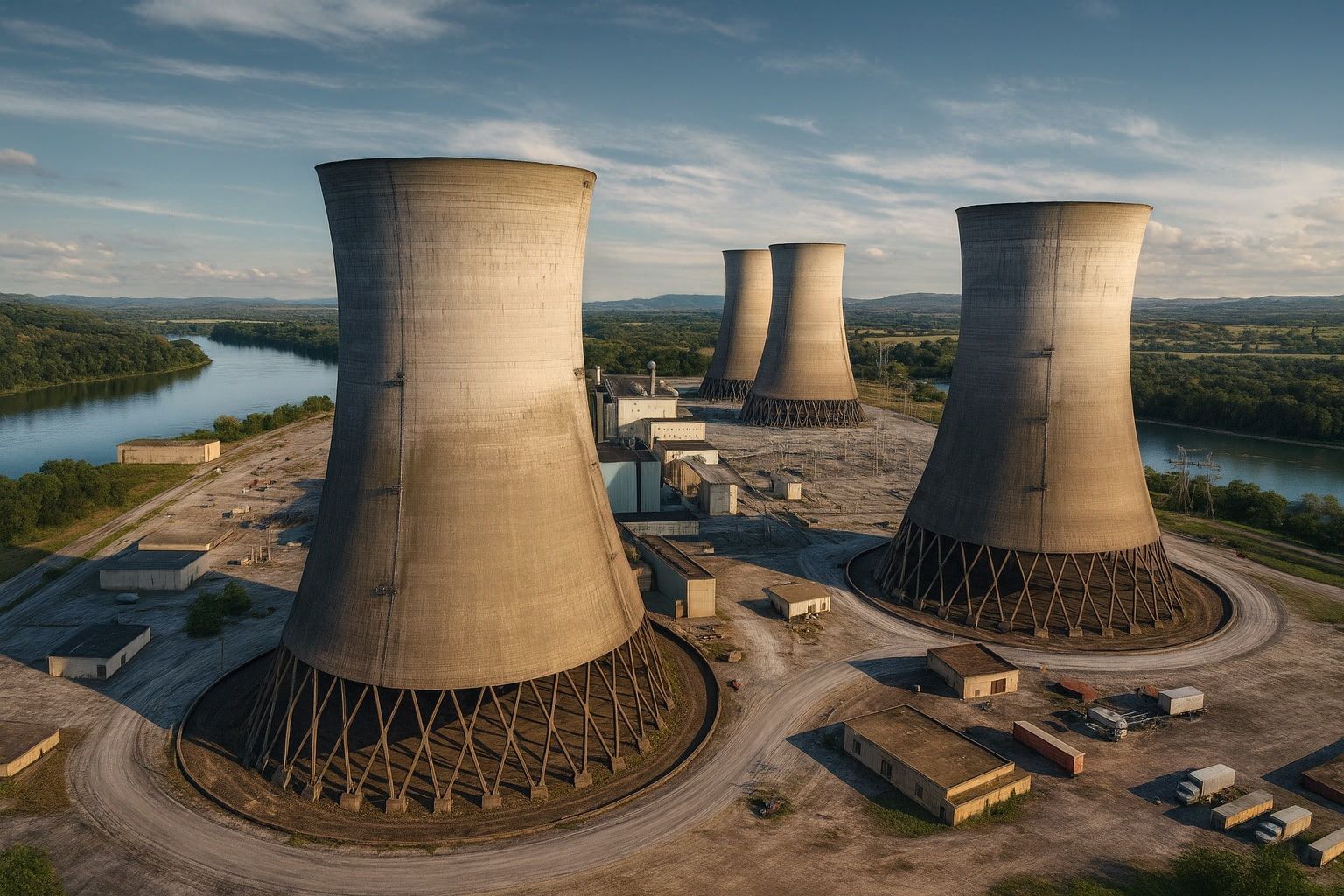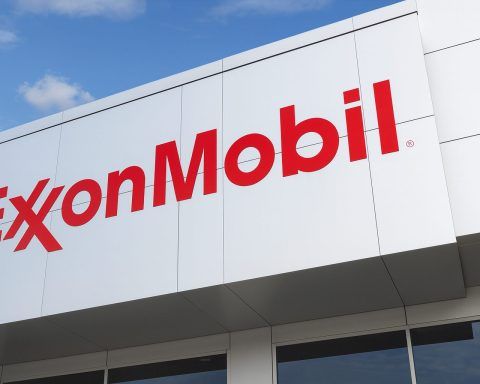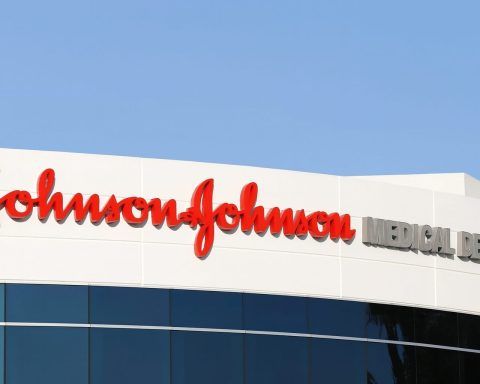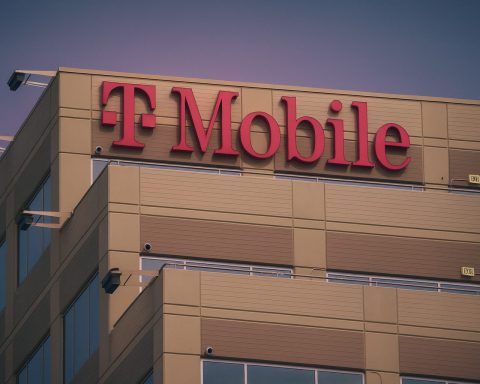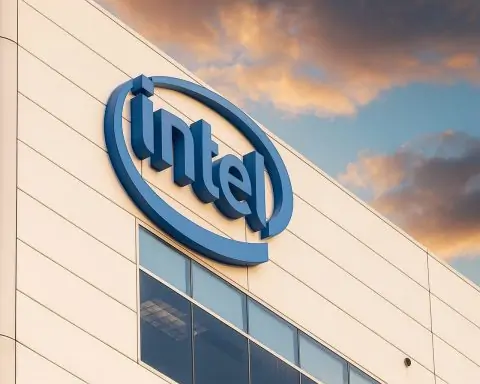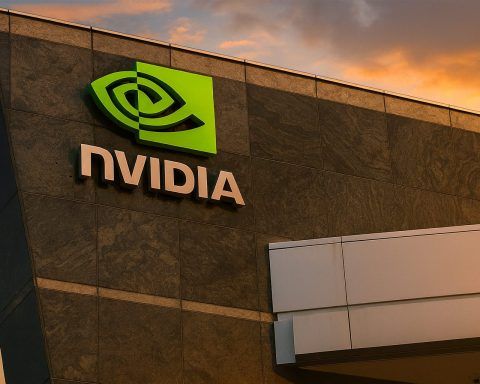- Historic $80B deal: On Oct. 28 the U.S. government struck a landmark partnership with Westinghouse owners Brookfield Asset Management and Cameco to build at least $80 billion of new nuclear reactors [1] [2]. The agreement, announced during President Trump’s Asian trip, aligns with his “energy dominance” agenda [3] and his May executive order to have 10 new large reactors under construction by 2030 [4] [5].
- Japan backing: Tokyo will provide up to $332 billion for U.S. infrastructure, including Westinghouse AP1000 reactors and small modular reactors, as part of a wider trade deal [6]. Japanese firms like Mitsubishi Heavy Industries, Toshiba and IHI could invest about $100 billion in U.S. reactor projects [7].
- AI and power: The Trump administration touts nuclear as crucial for the AI boom. Energy Secretary Chris Wright said this deal helps “energize America and win the global AI race” [8]. Each AP1000 reactor can power 800,000 homes large data centers, making it a “linchpin” for AI developers [9]. Major tech players are already moving into nuclear: Google and NextEra will restart a mothballed plant, and Google, Microsoft and Amazon have deals for next-gen reactors [10].
- Government stake: The U.S. will arrange financing and permits for the reactors in exchange for a profit share. After Westinghouse pays out $17.5 billion to Brookfield/Cameco, taxpayers get 20% of any additional profits [11]. If Westinghouse eventually goes public (valuation >$30B), the U.S. could take a 20% equity stake [12].
- Market reaction: Cameco (TSX:CCO; NYSE:CCJ), the Canadian uranium miner in the deal, soared on the news. Its U.S.-listed shares jumped ~25% on Oct. 28 [13], and TS2.Tech reports CCJ stock climbed roughly 10–15% in after-hours trading [14]. YTD Cameco is up about 65–80%, far outpacing major indexes [15]. Analysts note Cameco’s “low-cost, diversified mines and fuel business” make it a safe play to benefit from rising uranium prices [16]. Uranium spot prices are already at multi-year highs (~$70–75 per pound) and many forecasts see them reaching $80–100 [17].
- Job creation & industry: Officials say the rollout will create tens of thousands of jobs. Each two-unit AP1000 project sustains ~45,000 manufacturing/engineering jobs, and a broad deployment “will create more than 100,000 construction jobs,” cementing the U.S. as a nuclear energy powerhouse [18]. Commerce Secretary Howard Lutnick said the partnership “supports our national security objectives and enhances our critical infrastructure” [19]. Brookfield’s Connor Teskey noted his firm is doubling its infrastructure investment “as we deliver on building the infrastructure backbone of artificial intelligence” [20].
- Analyst outlook: Wall Street is mostly bullish on Cameco. Market surveys show a consensus “Buy” rating with an average price target around $90 [21] (CCJ closed near $88 on Oct. 24 [22]). Many analysts cite Cameco’s huge reserves, long-term contracts and strong cash flow [23]. CEO Tim Gitzel calls the new U.S. partnership “value creation” for Cameco [24]. Still, experts warn the long lead times and regulatory risks of big nuclear projects mean investors should “weigh valuations and monitor policy” closely [25].
Details of the Nuclear Pact
Under the deal, the U.S. will help finance and fast-track licensing for new Westinghouse AP1000 reactors on U.S. soil [26] [27]. Westinghouse — owned 51% by Brookfield and 49% by Cameco — will build the plants. In return for arranging loans and permits, the government gets a piece of the upside (20% of earnings above $17.5B) [28]. If Westinghouse ultimately IPOs at >$30B value, the U.S. could end up with a 20% stake [29]. This structure is intended to give taxpayers a return on investment once projects are profitable.
The deal grew out of Trump’s “Nuclear America” push: an April executive order mandated 10 new large reactors by 2030 [30] [31]. Trump and Energy Sec. Wright have repeatedly linked nuclear power to national security and AI competitiveness. Wright said the administration would “fully energize America” and “now he is delivering” on the promised nuclear renaissance [32]. Indeed, U.S. Energy Dept. guidance is now aiming to shrink reactor licensing times to 18 months (from years) to hit the 2030 build goal [33].
Japan’s involvement is unusually large. In Tokyo, President Trump won commitments of $332B for U.S. infrastructure — including funds for Westinghouse projects and small modular reactors [34]. A joint fact sheet says Mitsubishi Heavy Industries, Toshiba and IHI may funnel about $100B into U.S. Westinghouse reactor projects [35]. (Separately, Japan and the U.S. are moving ahead on nuclear cooperation despite recent disputes over trading Russian oil [36] [37].)
Nuclear Power as an AI Strategy
Why so much buzz about nuclear now? The answer: power-hungry AI data centers. Industry officials note that Google, Meta, Microsoft and Amazon are frantically expanding server farms for generative AI, and traditional grid capacity is straining. Each AP1000 reactor can generate ~1 GWe (enough for ~800,000 homes) [38] — comparable to the power draw of a large metropolitan data center. As the Washington Post reports, such reactors “provide unrivaled amounts of energy” and are seen as a “linchpin” for AI computing [39].
Already, tech giants are making nuclear bets: NextEra Energy and Google will restart an idle Iowa nuclear plant, and Constellation/Microsoft are reactivating a unit at Three Mile Island to power MSFT data centers [40]. Google, Microsoft and Amazon have also signed on to next-generation nuclear ventures (small modular reactors and even fusion) to secure carbon-free baseload power [41]. The Trump administration now argues that boosting nuclear is part of “energizing America” to win the AI race [42]. Even Democrats tacitly acknowledge more power is needed, though they stress renewables — in the last year wind and solar (with batteries) supplied ~90% of new U.S. power [43]. Some economists note that wind/solar remain far cheaper than big nuclear, and warn that a massive reactor build-out would likely take decades and risk large costs to taxpayers and ratepayers [44].
Market Reaction and Uranium Outlook
The nuclear pact sent ripples through markets. Cameco (CCJ) stock surged immediately: U.S.-listed shares were up ~25% on Oct. 28 [45], continuing a year-long rally (up ~70% in 2025) as uranium prices climb. TS2.Tech notes CCJ jumped roughly 10–15% on the news [46]. Brookfield Asset Management (BAM), which owns 51% of Westinghouse, also ticked up on optimism. By mid-week (Oct. 29), CCJ was near multi-year highs and BAM was solidly positive (exact quotes from markets as of press time).
Investors were already bullish on uranium stocks. Uranium spot is around $70–75/lb today – the highest in years – and analysts see $80–$100 before long [47]. Supply is tight (Cameco even cut 2025 output guidance) while demand forecasts are rising. The World Nuclear Association projects uranium demand up ~28% by 2030 [48]. Mining.com notes “revived interest in nuclear power” is fueling purchases as mines lag in ramp-up [49].
On Wall Street, Cameco has a consensus “Buy” outlook, with analysts targeting around $90 per share [50] (it closed near $88 on Oct. 24 [51]). Research reports praise Cameco’s huge reserves and long-term contracts for stable cash flow [52]. Even Brookfield and Cameco say the new partnership will strengthen their role: Brookfield’s president Connor Teskey calls it “value creation” for building AI infrastructure [53], and Cameco CEO Tim Gitzel says it supports “global growth opportunities” in nuclear fuel [54]. (Sources: Brookfield press release [55], Cameco press.)
However, analysts also caution patience. A TS2.Tech commentator reminds investors to “weigh valuations” and watch policy execution, since large reactor projects have long lead times and complex permitting [56]. In short, Cameco is at the center of today’s nuclear boom, but its continued gains depend on how smoothly these huge plant projects advance.
Experts’ Voices: Hope and Skepticism
Industry lawyers and analysts are sounding pro-nuclear notes. Thomas Ryan of law firm K&L Gates (Pittsburgh) calls nuclear “the baseload electrical power source of the future” and notes its deployment is now largely nonpartisan [57]. Secretary Lutnick said the deal “unleashes American energy” and “embodies the bold vision” of high-paying jobs and energy sovereignty [58]. Many experts agree that if the U.S. does move fast, it could reshape the global nuclear market (with Western technology instead of Russian/Chinese).
Yet critics abound. Bloomberg columnist Liam Denning warns this looks more like “nuclear policy with Chinese characteristics — and Japanese money,” noting the U.S. is effectively underwriting $80B of reactors [59]. Denning calls the pact “unusual” and even a “mess,” underscoring that outside China, no country builds big reactors cheaply or on-time these days [60]. Indeed, the last Westinghouse projects (the Vogtle AP1000 reactors in Georgia) ran seven years late and overran cost estimates (from $14B to ~$35B) [61]. Some experts caution that throwing federal money at nuclear may distort markets and burden taxpayers if projects falter.
Regulatory questions also loom. Critics note that permanent waste storage is still unresolved (spent fuel stays on-site in casks for decades) [62]. And recent moves by the White House to downsize the NRC and speed approvals have worried some safety advocates. Two NRC commissioners have already resigned under the administration, raising concerns about whether reviews might be rushed to meet the 2030 goal [63] [64]. Senatorial and environmental groups are likely to scrutinize the new deal as details unfold.
Challenges and the Road Ahead
Key uncertainties remain. When and if any reactors actually break ground depends on final contracts. Brookfield and Cameco say the government’s interest “must vest” only after formal investment decisions are made [65]. No timeline was given, and nuclear plants typically take 5–10 years to build once started. With only a few U.S. reactors (mostly small modular designs) currently under construction, ramping up $80B of projects will be a massive logistical challenge [66].
Economics is another hurdle. Nuclear power is capital-intensive. Even the Brookfield/Cameco press release footnotes emphasize that AP1000 plants have modular safety features, but only six are operating worldwide with 14 under construction [67]. Industry analysts note each new plant requires enormous supply chains and financing. Although the U.S. deal caps initial profit to investors, critics worry that if costs balloon again, taxpayers and electricity customers could end up footing the bill.
On the other hand, proponents argue the strategic benefits – clean baseload power and supply-chain security in the AI era – justify the cost. The Commerce Department frames the pact as part of rebuilding an “energy sovereignty” and reducing reliance on foreign fuel. If all goes as planned, the U.S. could see a nuclear renaissance: roughly $45,000 of jobs per two-unit project in dozens of states, plus billions of dollars in exported reactor technology [68] [69].
Forecasts and Next Steps
Looking forward, investors and policymakers will watch several key indicators: Cameco’s Q3 earnings (due Nov 5, 2025) for any updated guidance, the speed of NRC approvals, and whether Brookfield/Cameco line up specific plant locations and construction partners. Global uranium price forecasts remain strong – most analysts expect continued gains through 2026 given rising demand forecasts and limited new mine supply [70].
If Westinghouse succeeds and scales up, other Western utilities could follow. A positive outcome could revive dormant projects and spur a new round of nuclear investment worldwide [71] [72]. But as Bloomberg’s Denning warns, executing at “Chinese speed” may be unrealistic here.
For now, markets are treating the $80B deal as a bullish catalyst for the nuclear sector. Cameco and Brookfield stocks have jumped, and analysts have raised mid-term targets. Some forecasters predict nuclear will provide a steady chunk of future U.S. power as AI and data center demand grow. Yet as one strategist put it, investors should continue to “monitor” how policy, supply and global politics evolve [73]. With uranium prices high and government support building, the case for a nuclear comeback is compelling — but its success will hinge on overcoming the sector’s long-standing cost, schedule and regulatory challenges.
Sources: Government press releases and fact sheets [74] [75]; Reuters and Bloomberg reporting [76] [77] [78] [79]; TS2.Tech market analysis [80] [81]; Utility Dive and Washington Post coverage [82] [83] [84]; plus statements from Brookfield, Cameco and U.S. officials [85] [86].
References
1. www.reuters.com, 2. ts2.tech, 3. www.reuters.com, 4. www.bloomberg.com, 5. www.reuters.com, 6. www.reuters.com, 7. www.reuters.com, 8. www.washingtonpost.com, 9. www.washingtonpost.com, 10. www.reuters.com, 11. www.reuters.com, 12. www.reuters.com, 13. www.reuters.com, 14. ts2.tech, 15. ts2.tech, 16. ts2.tech, 17. ts2.tech, 18. www.utilitydive.com, 19. www.utilitydive.com, 20. www.utilitydive.com, 21. ts2.tech, 22. ts2.tech, 23. ts2.tech, 24. ts2.tech, 25. ts2.tech, 26. www.reuters.com, 27. www.washingtonpost.com, 28. www.reuters.com, 29. www.reuters.com, 30. www.bloomberg.com, 31. www.reuters.com, 32. www.washingtonpost.com, 33. www.reuters.com, 34. www.reuters.com, 35. www.reuters.com, 36. www.reuters.com, 37. www.bloomberg.com, 38. www.washingtonpost.com, 39. www.washingtonpost.com, 40. www.reuters.com, 41. www.reuters.com, 42. www.washingtonpost.com, 43. www.washingtonpost.com, 44. www.washingtonpost.com, 45. www.reuters.com, 46. ts2.tech, 47. ts2.tech, 48. ts2.tech, 49. ts2.tech, 50. ts2.tech, 51. ts2.tech, 52. ts2.tech, 53. www.utilitydive.com, 54. www.cameco.com, 55. www.cameco.com, 56. ts2.tech, 57. www.utilitydive.com, 58. www.cameco.com, 59. www.bloomberg.com, 60. www.bloomberg.com, 61. www.reuters.com, 62. www.reuters.com, 63. www.reuters.com, 64. www.washingtonpost.com, 65. www.reuters.com, 66. www.reuters.com, 67. www.cameco.com, 68. www.cameco.com, 69. www.utilitydive.com, 70. ts2.tech, 71. ts2.tech, 72. www.bloomberg.com, 73. ts2.tech, 74. www.cameco.com, 75. www.cameco.com, 76. www.reuters.com, 77. www.bloomberg.com, 78. www.reuters.com, 79. www.reuters.com, 80. ts2.tech, 81. ts2.tech, 82. www.utilitydive.com, 83. www.washingtonpost.com, 84. www.washingtonpost.com, 85. www.cameco.com, 86. www.utilitydive.com
